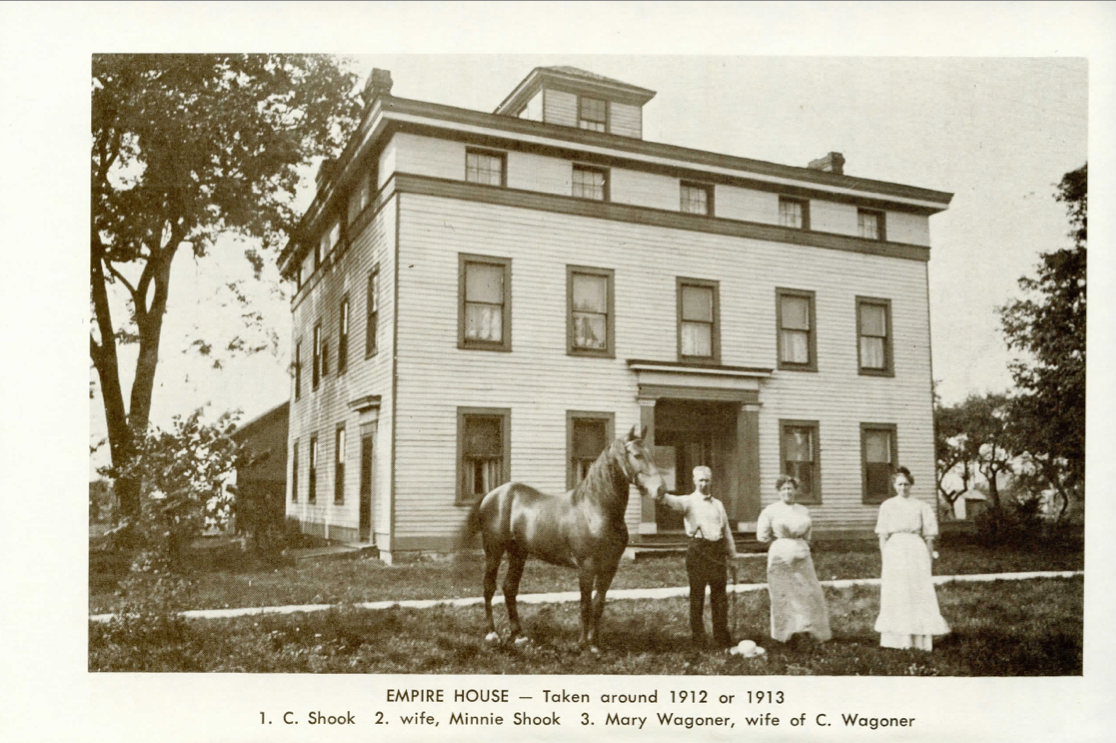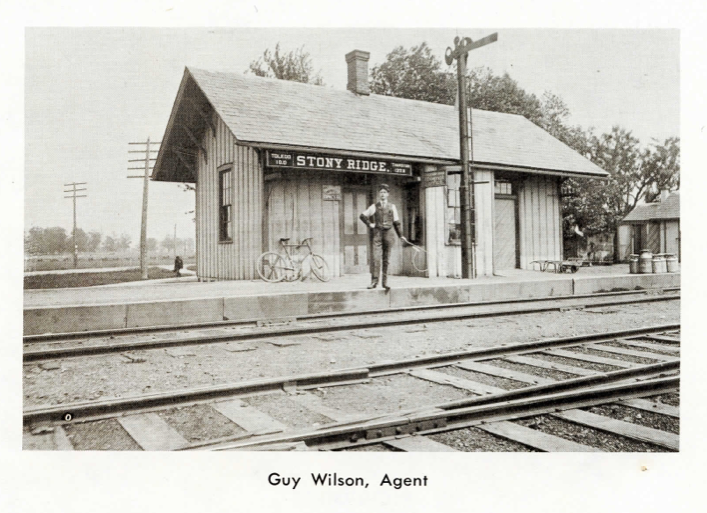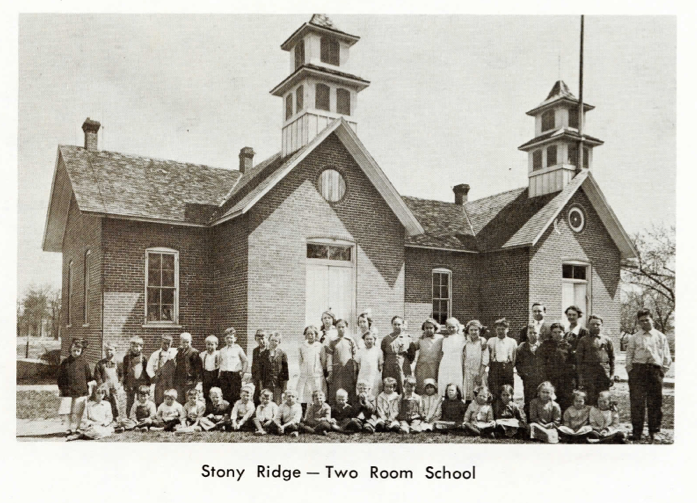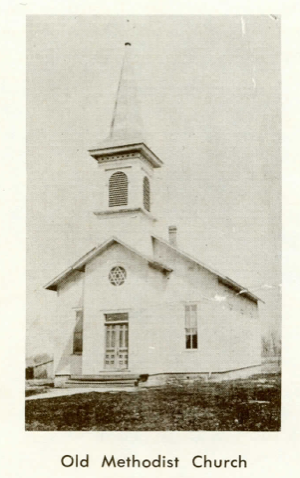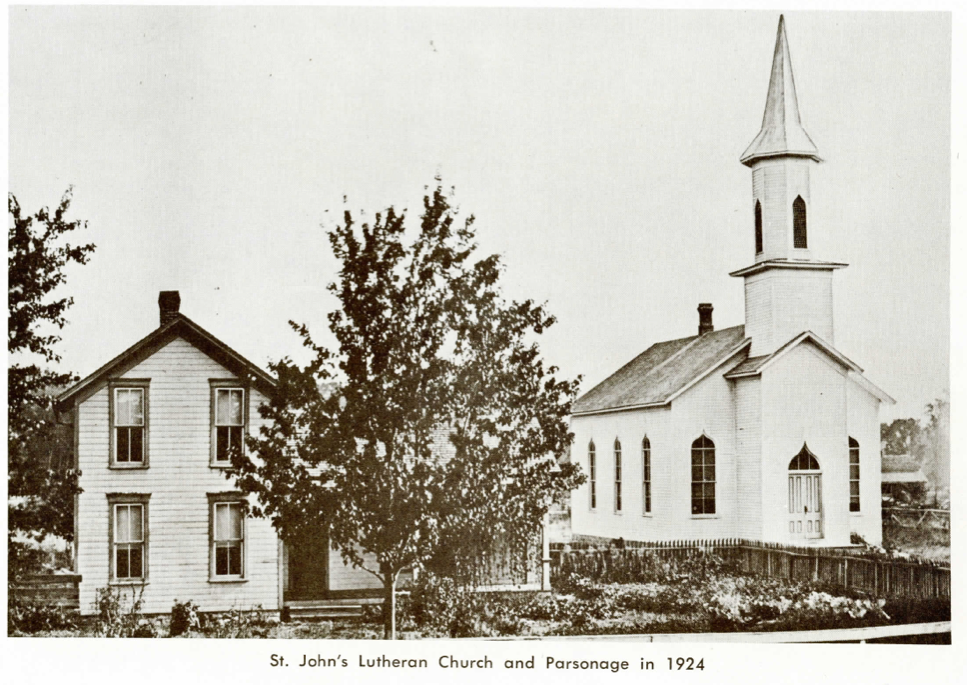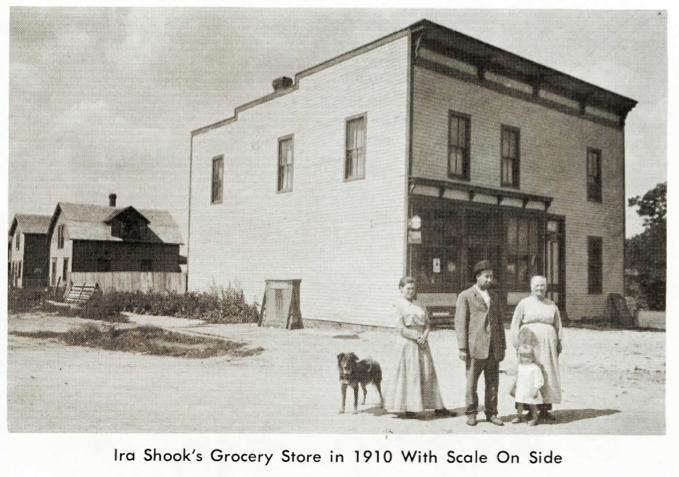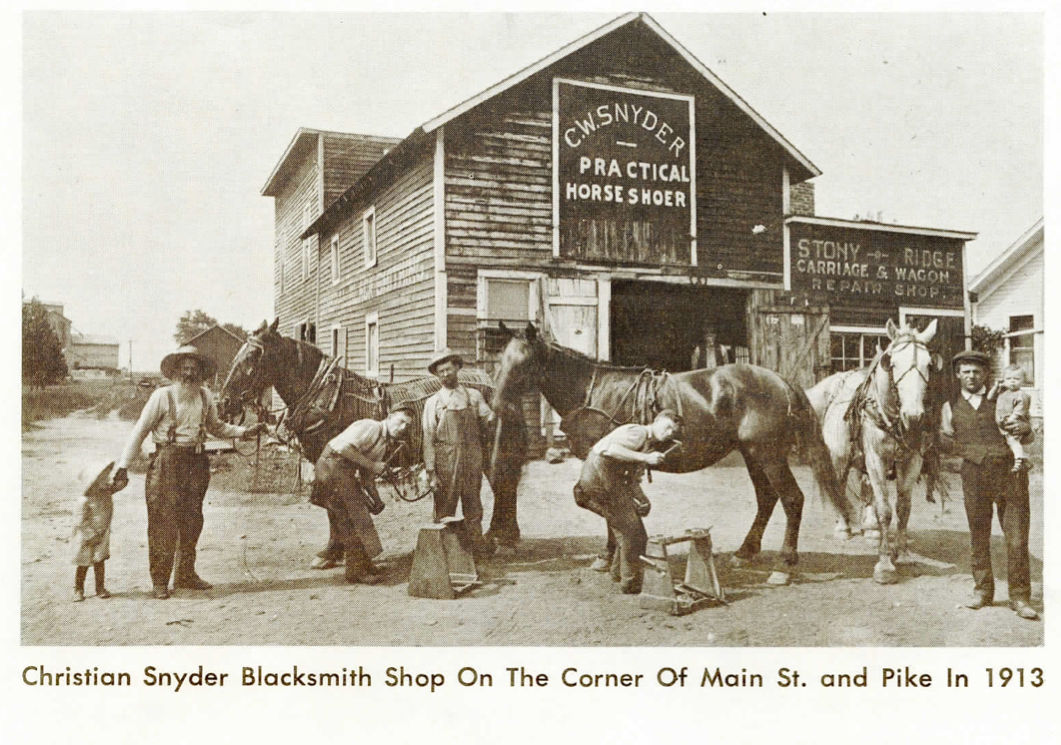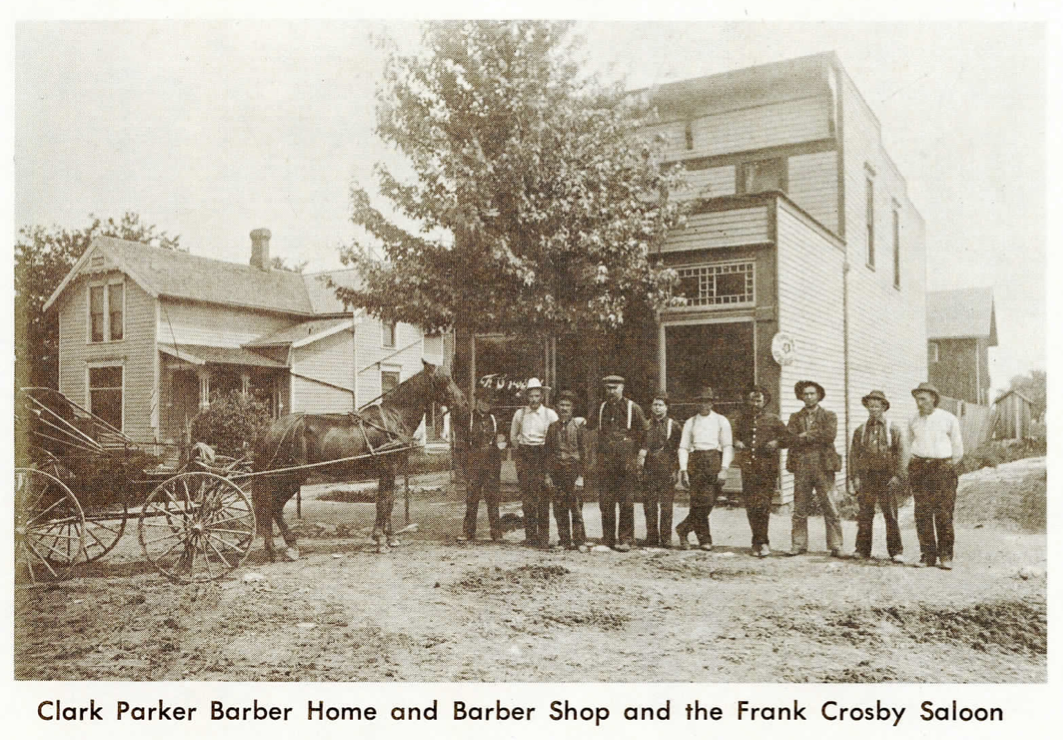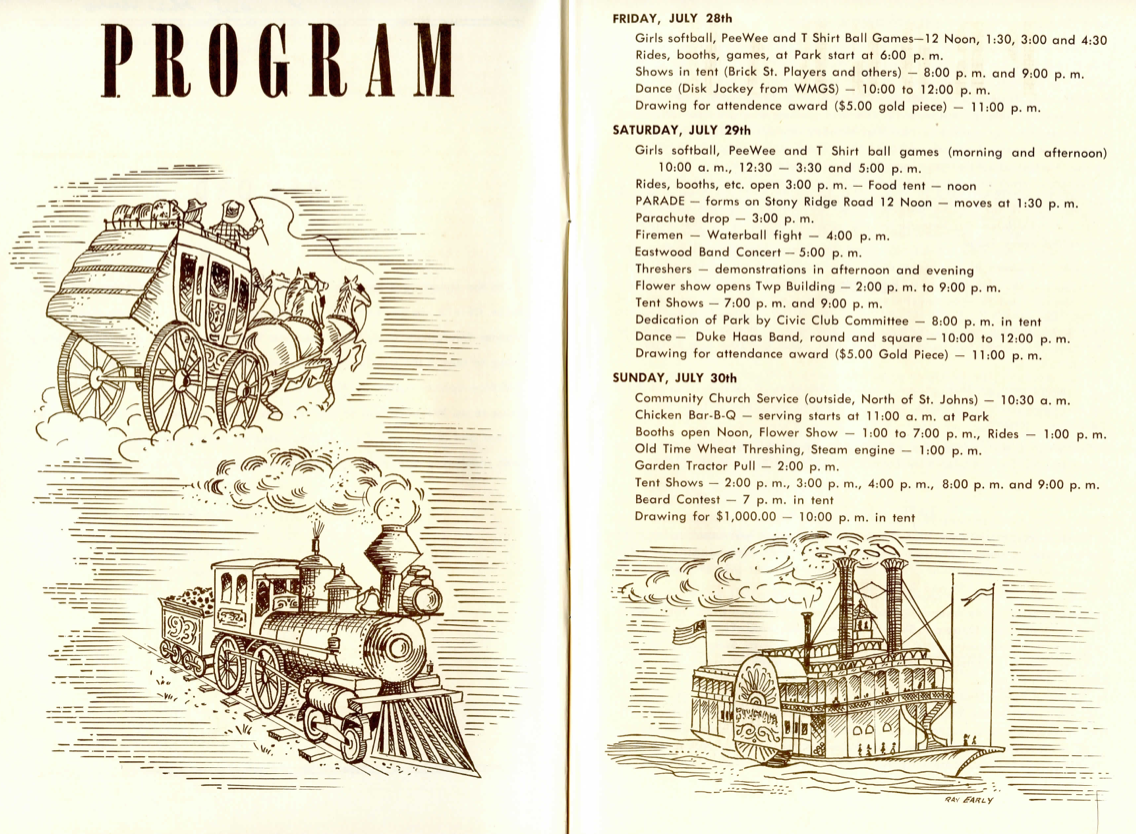 “The Pike” in this text refers to what is now route 20.
“The Pike” in this text refers to what is now route 20.
STONY RIDGE, OHIO
CENTENNIAL
1872 – 1972
FOREWORD
On the following pages we have endeavored to record a history of Stony Ridge, Ohio. It has been difficult as there are few records we could consult. Our pioneer forefathers must have been too busy meeting the demands of daily living to record the events affecting their lives. The Commemorative Historical and Biographical Record of Wood County published in 1897 has been of much value to us. We have had to rely to some extent on the memory of our older citizens and Mr. Jerome Calkins, who spent his early years here. Their aid has been invaluable and much appreciated and we thank them one and all.
Levada E. Hurrelbrink
Lelia Schulte
Grace Metzger
Gladys Sibbersen
—– + —– + —– + —– + —– + —– + —– + —– + —– + —– + —– + —– +–
STONY RIDGE, OHIO
As Stony Ridge is an unincorporated village in Troy Township, Wood County, it is fitting that we state this division of Wood County was surveyed in 1820 by Charles Roberts. The settlement of this township may be said to have begun in 1833. Troy Township as established December 1, 1834, embraced Congressional Township No. 6 in Range 12. The first election was ordered to be held at Thomas Leaming’s house on the first Monday in April, 1835. The Township was left intact until December 8, 1846 when Sections 19, 20, 29, 30, 31 and 32 were attached to the new township of Webster.
The village was surveyed in May, 1872, for Caleb Bean on Road Tract 59, and that part of tract 38 for Samuel Shriner by George Kirk. The name Beanville was considered but because of the physical character of the locality it was called Stony Ridge.
GEOLOGY
The ridge which is an integral part of Stony Ridge is a limestone. It is too hard to be suitable for lime burning. It is also free, or nearly so, of all kinds of fossils. It is good for building construction, road building and ballast for railroads.
The stony part of Stony Ridge is mostly boulders of granite carried here from Canada by huge glaciers during the Glacial Age, and left behind when the glaciers melted.
The weathering and erosion of the limestone combined with the glacial debris has built a fertile and arable soil in the Stony Ridge area.
EARLY INHABITANTS
There is ample evidence that the Stony Ridge area was inhabited by the Mound Builders several thousand years ago. Although no mounds have been found inside the town, there are remains along the east side of the Maumee River in and near Toledo and Rossford.
The mound builders were followed by Indians of various tribes such as the Miamis, Wyandots, Ottawas, Shawnees, Delawares and Chippewas. Pontiac and Tecumseh were celebrated Indian Chiefs of the Stony Ridge area. Pontiac was born near Ironville and Tecumseh not too far south of here. Little Turtle, Ottokee and Logan were other famous chiefs. Most Indians left the area after the Battle of Fallen Timbers and the Treaty of Greenville although some fought with the British in the War of 1812 at Perrysburg, Maumee and Fremont. The Battle of Lake Erie and the Battle of the Thames in Canada resulted in the death of Tecumseh and the expulsion of the Indians from this section of Ohio. We know that they were here by the artifacts which have been found.
After the War of 1812, permanent settlers came from New England, New York, Pennsylvania, Germany and Switzerland.
PIKE
In a treaty the Indians gave the United States government a strip of land two miles wide from Perrysburg to Fremont for a military road. Probably one of the most important improvements in this part of Ohio was commenced in 1825, when a “mud pike”, The Western Reserve Road, was constructed from Lower Sandusky, (now Fremont) to Perrysburg, a distance of thirty-one miles. It was authorized by Congress in 1823. It had tall gates and thirty-one taverns. Even though schooner, brig and steamboat carried many of the thousands who settled in the West, the direct route for many other thousands who traveled overland, was through the Black Swamp and Stony Ridge. The pioneers and old settlers related that mud-holes were created for revenue purposes, that yokes of oxen for helping to extricate teams were kept in readiness, and that mud-holes were convenient to each tavern. It was said that one of the mud hole owners, becoming tired of this “holey” department of his business, sold his interest to a neighbor for $5.00 hoping by this means, to a escape retribution in the next world, and the curses of the immigrants, who were delayed in their westward travels.
The completion of the Pike opened the dense forests of oak, ash, elm, walnut, hickory, cottonwood, cherry and many other varieties to the lumbermen; but also to permanent settlers in the vicinity. They could go to Perrysburg, which was then more important than Toledo to this area of Northwestern Ohio, or to Fremont or Woodville, at any time of the year. They could take their grain to mill or market, whenever they chose to do so, and could dispose of their produce at any time.
In 1838, Ohio paid $40,000 to surface the Pike with stone which was finished in 1841. Milestones were set in 1842. Drainage ditches and culverts were added somewhat later at a cost of $125,000. When finished, it was the first stone road (raised roadbed topped with thick layers of stone) in Northwestern Ohio.
After the Pike was finished, it soon became a well traveled highway. It was a toll road, and at distances of approximately ten miles or so, toll gates were established. One gate was west of Woodville and one east of Perrysburg a few miles. A swinging gate barred travelers going farther until the toll was paid. A toll keeper was housed thereat. In 1846 the toll was 81 cents for the entire length of the Pike, the bridge toll at the Maumee River was 66 ½ cents. Martin Van Buren Shook and his sister Fannie Shook Newcomer worked on the toll gate.
EMPIRE HOUSE
As traffic increased, taverns and inns were established to care for the travelers’ needs for lodging, food and refreshments. The remains of many of these establishments can still be seen along the Pike, but perhaps the most famous of all of them is the Empire House built at the peak of the ridge at the eastern edge of Stony Ridge. It is still a famous landmark.
It [the Empire House] was built in 1848 or 1849 by John Elderkin. It seems to have been a successful hostelry from the start. It was centrally located, being midway between the toll gates near Woodville and Perrysburg. It had clean rooms, an excellent kitchen, and a refreshing bar. One of the main attractions was a ballroom, which took up the whole east side of the second floor. The ballroom was unique not only on account of its immense size for that time, but because the floor was anchored in such a way that it rose and fell as the dances passed over it.
Young men and their lady friends came from far and wide to the Empire House to dance and be entertained. There was a large barn where their horses could be cared for while the owners danced. There was considerable drinking and much rivalry between the parties from different towns. It sometimes led to serious brawls between the various visitors from rival villages.
A place as famous as the Empire House is sure to have many legends attached to it. A maid who was employed at the Empire House at the time it occurred related the following:
A man and a woman appeared at the Empire House one evening. It was evident that they had been quarreling violently. They registered and shortly went to their room. About 2:00 a. m. the people were awakened by a woman’s screams, and found the huge barn on fire. All the men rushed to get the horses out of the barn. They succeeded in getting the horses out but a large bull quartered in or near the barn was badly burned and had to be destroyed. Charles Furry loaded the gun with an extra big load. He destroyed the bull, but the gun exploded and blew his thumb off. In the excitement the couple were forgotten. They were never seen again. It left many questions unanswered.
John Elderkin sold the Empire House property in 1856 to Henry Seabert. Seabert sold to Caleb Bean in 1868. At his death the property descended to George Bean who sold it to James B. Luckey in 1893. In 1894 it was sold to J. Kent Hamilton and 1903 to Charles H. Shook. The property changed hands again when Jay Keil bought it about 1950 Hiram Hurd and James H. House bought it and established an antique business there. In 1960 Roger L. Hillabrand and his wife bought the property and continued the antique business to date.
RAILROADS
In June, 1869 the Atlantic and Lake Railroad became the Ohio Central company to build a railroad from Toledo, Ohio to Columbus, Ohio through Fostoria, Bucyrus and Atherson, Ohio. Its name was later changed to Toledo and Ohio Central Railroad Co. It consisted of two lines from Toledo. The Eastern division went through Stony Ridge; the Western division through Lime city to Columbus and met at Thurston, Ohio.
The first passenger train went to Columbus on January 10, 1877. The three decades of 1850, 1860 and 1870 were a time of great activity in railroad building. There was one main line track and passing siding about a mile long where passenger and freight trains could pass in Stony Ridge. There was a spur track to the sawmill and one to the quarry. Martin Van Buren Shook built railroad stations. There was a depot with a passenger waiting room, an office, and a freight room. There was a long platform and a mailcatcher at the south end of the platform. The waiting room was warmed by a pot-belly stove that was often red hot on cold winter mornings. The room filled with commuters There were six trains a day except Sundays, three going north and three going south. The train usually consisted of an engine and tender; a combination mail, express and baggage car with a compartment for smokers; and one to three coaches for passengers.
In the early days the coaches were made of wood, later of steel. The seats were covered with red or green plush and could be turned to face either way, forward or backward. There were oil lamps in the ceiling; a water container with a tin cup chained to it; and in winter, a stove; There was also a toilet in each coach. There were no air-brakes nor automatic couplers. Everything was done by hand.
In addition to the six passenger trains daily there was a local freight train out of Toledo to Bucyrus in the morning and one back to Toledo in the afternoon. Both trains carried local freight for stations along the way anbd picked up empty or loaded freight for stations along the way and picked up empty or loaded freight cars at all stations. In an emergency they could carry passengers in the caboose.
SCHOOLS
In 1833, when William Gorril and his wife made their first home in Wood County, in Troy township, Mrs. Gorrill organized a school in her cabin, and thus became the pioneer teacher in Troy Township. This is believed to be on the Pike just east of Stony Ridge a very short distance. An enumeration made in 1857, credits Sub-district No. 1 with twenty-seven male and seventeen female children belonging to Henry Elder, Thomas Gorrill, James McCutcheon, James K. Knaly, H. Siebert, Joseph and S. Shook, Fred Swartz, A. Snyder, William Zacharias, and Augustus LaFerree.
The one story brick building which was located on the hill between the two churches was built in the year 1876. Wesley Bean of Stony Ridge was the contractor and builder. Miss Emma Hueston of Perrysburg was the first teacher. Among the first pupils were; Emma, Gust, Minnie, David, Christ and Anna Snyder; Maggie, Lizzie, George and Mary Frische; Carry and Emma McCutcheon; Anna, Lizzie and George LaFarree, Sammy Shook, Letty Shriner, Orville Piper, Addie and Sarah Furry, Carrie and Charley Puse, John, Ida and Emma Gast; Maggie Gould, Cora, Henry and Harvey Baker and Lois Bean.
In 1927 the schools at Lemoyne and Stony Ridge were closed and the pupils attended the new centralized school at Lemoyne, called North Troy. The first teachers in this six-room building were Louise Ault, Carrie Bringman, Mable Brown and Naomi Obermyer.
STONY RIDGE METHODIST CHURCH
The Stony Ridge Methodist Church was born as a result of a camp meeting held down on Mud Creek in 1839 or 1840. The religious fervor inspired the formation of a Sunday School class in the pioneer community. Some of the original group were Jacob and Fanny Furry, John and Peggy Noel, James Moor, John Goss, James LaFarree, Sr., James McLargen, Joshua Smith, Sr. And their wives, Mrs. Gorrill, Mary Smith and John Reed.
The group met in homes and grew both in size and spirit. In 1856, they organized as a church formally, the Methodist Episcopal Church. Conflicting stories exist about the construction of the first church building. Some believe that it was built in 1856, but it is generally thought that it wasn’t until 1872 that a simple church was erected on the east side of the road that is now Ohio 163, approximately across from the present Lutheran Parish House. The early members continued to meet in their homes in the original New Testament Style until the little church was constructed.
About two years earlier (1870), a Methodist congregation was started in Luckey which met in a school house. The school was removed, so the Luckey people joined Stony Ridge in their new building for ten or twelve years until the Luckey folks built their own church in 1888.
Mrs. Eliza Robinson, the Stewarts, McCutchens, Catherine Eagle, George and Hattie Wagoner, William and Ella Wagoner, Henry and Rosina Wagoner are some of the names on the roll at this time.
The present building was built in 1889 and the little old church became the temporary home of Eugene Morris. Today it is on the Emanuel Petersen farm used as a farm building.
The new church was dedicated December 1, 1889. Mr. Albrittor was the Presiding Elder (Dist. Supt.) and the Rev. C. M. Myers the preacher in charge. It is especially interesting that the first babies baptized in the new sanctuary were Lloyd Wagoner and Rolland Shook.
People came, worshipped, brought their babies for baptism, joined the fellowship, were married and buried from the Church on the Ridge. Many people met their Saviour in Revival Services held throughout the years. Most of all, the Stony Ridge M. E. Church was a witness of Christian Faith throughout the years. Eventually its growth demanded more space.
Although truly “built on a rock”, the floor was raised three feet up and a basement excavated. Most of the work was done by the members and friends of the church and the new basement was dedicated in 1928.
The end of the depression and the war years brought new growth. In 1941, Stony Ridge was separated for a short time from the Pemberville Charge and shared Rev. Rhodes with the Providence Church. This did not last and the time honored relationship was rejoined. The “Episcopal”
part of our name was dropped in the great union of the Methodist Churches in 1940.
A Hammond Organ was purchased in1949 and has been a source of inspiration and beauty in the worship service. IN 1953, the congregation decided to put three class rooms, rest rooms and a kitchen on the rear (north) of the building, as well as an altar and Picture window in the sanctuary. Completed in 1954, it was dedicated in 1960 as the new unit was consecrated. New furnaces were added in 1958 and the continual growth, the condition of the front siding and the deterioration of the bell tower impelled the official board to begin the construction of the renovated front. A parlor and cloak room of many uses, lobby, new steeple and a remodeled exterior in New England Architectural style has been added. New chandeliers and spotlights have been installed in the redecorated sanctuary.
ST. JOHN’S LUTHERAN CHURCH
The beginnings of Saint John’s take us back some years previous to the organization of the congregation. At the time that it came into existence, Stony Ridge had not yet been surveyed, and this section of Ohio still deserved the name “Black Swamp”. Who of those early settlers as they made their way laboriously past log huts and shanties, over almost impassable trails or corduroy roads, would have dreamed that the swamp would blossom as a rose and become an ideal agricultural district as we behold today—with its magnificent farms, comfortable homes, improved roads traveled by automobiles—with its telephones, mail carriers and electric lights as well as other conveniences and comforts that never entered the imagination of the early settlers? A church home such as we have was scarcely a dream as the early fathers and mothers gathered in that school in the Hopper settlement.
The pioneers of this church were among those who blazed the way to make this section what it has become. They penetrated the forest with shining ax and sturdy arm, with empty pockets but hearts full of trust in God. They began to clear the land and establish homes. What labor, anxiety and sorrow it cost them, how much patience and perseverance was required, we today cannot realize, we who view the land dotted with beautiful homes and well-filled barns.
Many of the earlier settlers were of Lutheran faith. They had come from established churches in older communities and they longed for religious privileges such as they had enjoyed. What a joy it must have been to these scattered Lutherans when they were supplied with religious services. Mostly on foot over well-nigh impassable roads and trails they came, thankful for this privilege which was theirs about once a month for five years. It has not been possible to ascertain the exact years of this service though it must have been begun shortly after 1850. It was not an organized congregation., It was what is termed a preaching pint. During Rev. A. Buerkle’s ministry, services in the schoolhouse were discontinued. The congregation moved to Stony Ridge.
An organization was affected by Rev. Buerkle in the year 1869, under the name, St. John’s Evangelical Lutheran Church of Troy Township, Wood County, Ohio. The exact date when this occurred is not available as it was not placed on record. The closest we have been able to determine the date is the winter of 1869 – as Rev. Buerkle placed only the year in the original church book.
The number and identity of the original members is not absolutely certain. The following thirty-nine men were listed in Pastor Born’s notes as the heads of our original families:
- George Akenberger
- Carl Beckman
- Andrew Betz
- Carl Bredow
- John Brosse
- John Buck
- Jacob Christian
- Conrad Cutler
- Christ Eicholz
- Julius Franz
- Samuel Goshert
- John Christian Hasel
- Fred Heideman
- Elias Hanely
- George F. Kepler
- Gotlieb Kepler
- Jacob Kurfess
- Martin Kuttler
- John Langendorff
- John G. Lederer
- John Christian Meier
- George Messmer
- Louis Metzger
- George Andrew Miller
- John Mullett
- Jacob Meyer
- Christian Nollenberger
- J. G. Puse
- Jacob Sargent
- John Adam Snyder
- Adam Snyder
- Daniel Snyder
- John Spiess
- Frederick Stroble
- Jacob Frederick Swartz, Sr.
- John Swartz, Sr.
- Lucian Swartz
- P. Von Ewegen
- Bromain Warns
For about one year the congregation worshipped in a building which stood on the side road just north of the present church. On March 16, 1872, the congregation was given the present lot for a church building. The lot contains one acre and was generously donated by Mr. and Mrs. Frederick Swartz, original members of the congregation (The church property was increased in 1881 by the purchase of property from the Swartz family, an additional lot to the north was donated in 1939 by the Herman Franz family; a lot east of Route 163 was given to the church, for its use, in the 1950’s by the Harold Nollenberger family; another lot further to the north was donated in 1967 by the families of Walter Franz and Charles Franz, Sr.)
One thing is evident—the congregation has prospered without the use of worldly methods to raise money. Direct giving has been practiced. The Ladies Society contributes to missions and maintains the interior of the church.
The Sunday School was organized July 30, 1895. It has been a strong partner and blessing to the church. It contributed the beautiful altar window—a scene which to the Christian heart is so impressive and gripping—that awful yet sublime night in Gethsemane, when the Savior in agony was bearing the world’s burden of sin, yet in humble prayer submitting to the Father’s will to drink the bitter cup to its dregs. May this scene, which will always confront you at service, serve to leave an imperishable impression on mind and heart of salvation’s cost.
This brings us to 1919. (Here ends Pastor Born’s original history and notes).
The second fifty years of the congregation’s life have brought change and growth in many ways, even as our nation and way of life have experienced these same factors in the past half century. In September of 1933 death ended the pastorate of Pastor Born. For 46 years, from 1887 to 1933, he faithfully led the congregation through many years of growth and witness. His love and devotion to the parish is attested to by the fact that it was the only congregation he ever served during his entire ministry.
In March of 1934, Pastor Dwight L. Miley began his ministry here, serving for six years. Under his guidance a parish house was planned for and constructed, thus providing much needed space for the Sunday School which, heretofore, was crowded together in the nave and balconies of the church building. Also begun during this pastorate was the Jesse Thomas Missionary Society, which was the successor body to the Ladies Aid Society, originally started in 1896.
In 1940, Pastor Herbert W. Veler began a ministry of eleven years at Saint John’s. He led the congregation through a trying time in our nation’s history when, like other parishes, many of the young men and women were called to serve in Europe and the Pacific during World War II. More than 75 of our members served gallantly and three paid the supreme sacrifice of dying in defense of our freedom. In grateful recognition of all of these, who served with such courage and loyalty, a set of carrillonic chimes was dedicated in 1947 by the members of Saint John’s, and these bells are still reminding us today, through their lovely sounds, of their sacrifice and service to country.
Pastor Veler was called to Zanesville in 1951 and Pastor David L. Scharf became pastor in May 1952. Pastor Scharf served faithfully for eleven years also, until 1963. After approximately 75 years of independent status as a congregation, Saint John’s was received into the membership of the Synod of Ohio of the United Lutheran Church in America, in May of 1962. In the same year we joined with 6,000 other congregations throughout the United States and Canada in the merger which produced the Lutheran Church in America, the largest Lutheran body in North America.
In 1963, Pastor Scharf was called to the staff of the Ohio Synod and the congregation had no pastor for fifteen months. Then in May of 1964, Pastor J. Pennell Neikirk accepted a call to serve Saint John’s. In 1965 a Long-Range-Planning Committee was appointed to study the projected future life and needs of the parish. After several years of evaluation and planning, th5e decision was made by the congregation in 1968 to enter a building program to provide the facilities that are and would be needed in future years. The Parish House was moved farther north and west on the lot, a new church was built where the parish house had stood and the old church was razed. The new building was dedicated on February 8, 1970.
On April 1st, 1972, Pastor Niekirk left the congregation, having accepted a call to a Columbus, Ohio church. Dr. Herbert Veler is now acting as pastor of the congregation.
EVANGELICAL ASSOCIATION CHURCH
About 1896, an Evangelical Association Church was erected on the east side of Main Street about 200 feet south of the Pike and services were held. Rev. Steffani was the first pastor. This building was sold and moved to Maple Street by John Korn. Later it was sold to Nelson Klink. A new church was built and about 1919 was sold to the Stony Ridge Lumber Company and moved to their property to be used for an office.
DOCTORS
Stony Ridge was fortunate in having the services of several doctors. Dr. Henry H. Buckland was one of the earliest. He was from England and lived on the south side of the Pike. In the corner of the Haag farm next to Dr. Buckland were the remains of an old tile kiln. Dr. Buckland’s English heritage showed in that he kept peacocks and a parrot.
Across the Pike from Dr. Buckland lived Dr. Cyrus Noble. He was a young doctor just out of Old Toledo Medical College about the 1880’s
Dr. Noble moved to Toledo and Dr. Buckland passed away. Dr. Andrews came to take their places. He was rather old, when he came to Stony Ridge. He occupied Dr. Noble’s home.
In 1895, Dr. William H. Price and his wife, Florence, a practical nurse came to Stony Ridge. They built a home and office on the southwest corner of the Pike and Bean Street. They faithfully served the community until their retirement in 1940, when their son, Dr. Frederick F. Price, too over the practice. Mrs. Florence Price was a real help to her husband, assisting him in many ways both on his calls and in the office. They were vitally interested in the affairs of the community.
Dr. Frederick Price practiced in Stony Ridge until April 1958 when he moved his office to Ayers Road and the Toledo-Detroit Expressway.
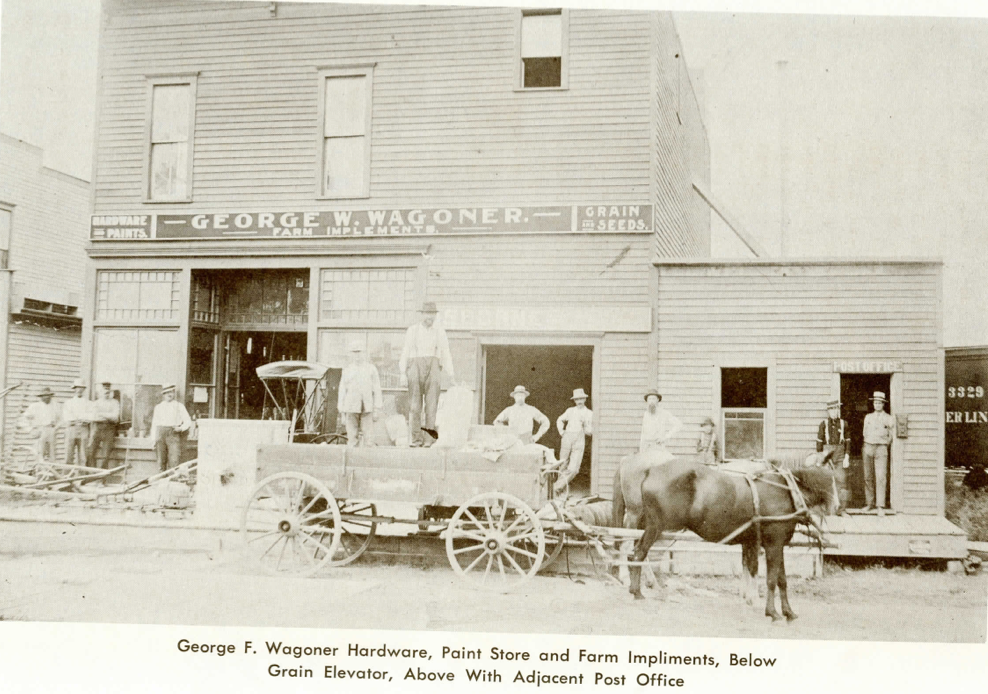
George R. Wagoner Hardware, Paint Store and Farm Implements, Adjacent Post Office, Stony Ridge, Ohio
POST OFFICE
The Stony Ridge Post Office was established on July 15, 1837, discontinued on May 6, 1864 and reestablished on July 13, 1866. The postmasters and dates of appointments wee as follows:
- James Leffrey – July 15, 1837
- Orange Howard – March 5, 1839
- Henry L. Wood – August 12, 1845
- John P. Elderkin – October 9, 1855
- Joseph Seabert – July 14, 1856
- Henry Seabert – May 14, 1857
- Charles H. Richards – May 23, 1861
- Jerome McCutcheon – July 13, 1866
- Henry Buckland – May 24, 1869
- Samuel Shook – March 12, 1888
- John E. Stewart – November 22, 1889
- Edward F. Metzger – November 16, 1893
- George W. Wagoner – November 27, 1897
- Samuel E. Wagoner (declined) – March 28, 1900
- Frank Wagoner – July 24, 1900
- Ira E. shook – September 7, 1909
- Leroy H. Hurrelbrink – March 31, 1937 (acting)
– April 1, 1937 (assumed charge)
– July 21, 1937 (confirmed)
- Charles E. Franz – May 31, 1965 (assumed charge)
– May 8, 1967 (confirmed)
Walter Kurfis was appointed July 16, 1907, the first rural carrier to serve the area from the Stony Ridge office. Later John R. Brough, Lee Shook and Lloyd Wagoner served. Rural service was discontinued from the Stony Ridge office and the area is now served out of the Perrysburg, Ohio office.
BUSINESS ESTABLISHMENTS
As Stony Ridge was surrounded by the Black Swamp it was natural that it should have forest related industries such as a sawmill. The first saw mill was established near the railroad at the junction of Oak and Railroad Streets. It is said there were piles of lumber higher than the telegraph wires and a [pile of sawdust covered three acres. Some of the lumber was shipped by rail and the sawdust was shipped to Central Ohio to a manufacturer of pails.
A planing mill was added to the sawmill and a box factory was established. The lumber was sawed, planed and made into very fine boxes. Some of the logs brought to the sawmill were very large so that a smaller circular saw was needed above the large circular saw to completely saw through the huge logs.
Wooden bowls were also cut out of hugh blacks of wood. Some of the bowls were used for decoration. Nearly every house had bowls about ten to twelve inches in diameter hanging on the wall. Some of the bowls were painted whatever color desired and while the paint was still wet, it was sprinkled with a pulverized ore, which made it reflect light. The ore came from a wreck on the railroad.
Near the same site the present lumber company was started in 1918 by George and Fred Henning, building contractors, John Warns, August Elliott and John Emch. It was first managed by Robert Baker and then by John Emch. It was incorporated in May 1919. In 1920, Arthur Hagg became manager until his retirement in 1960 and his son Robert V. Hagg is the present manager.
About 1897 or 1898 George Wagoner, who owned the sawmill, built and operated a grain elevator. This was constructed of wood and was later burned. The property was purchased by Elliott and Beasley and the elevator was rebuilt. The elevator was managed by August Elliott until it burned in 1941.
A coal yard owned by August Elliott and Mrs. Arthur Hagg (Edith) was operated in conjunction with the elevator for a number of years. A tile factory was opened in the village by S. E. Wagoner.
Joshua V. Smith came to Stony Ridge in 1832 and was the first to enlist in Troy Township for the Civil War. Returning to Stony Ridge in 1865 he resumed farming and brick making.
A hoop and stave factory was built in 1881 by Marshall R. and Samuel Gorrill. It was burned in 1885.
Samuel Shook came to Stony Ridge in 1855 and was a farmer, plasterer and brick layer. He operated the Empire House from 1872 to 1882. He then erected a two-story brick store building and carried on a grocery business for eleven years. He married Clarissa Smith, daughter of Joshua and Hulda (Alger) Smith and was the father of Amos C. Shook and Emeline, wife of Noah Bean. This brick store building was used by the Thornton Bros. for a bakery. Ben Bahnsen had an ice cream parlor and Albert Brodersen, Roy Rogers, and Ralph B. Myers each sold general merchandise. Ralph B. Myers sold the business to Leroy H. Hurrelbrink in 1932 and in 1950 he also bought the property which he immediately modernized. Leroy H. Hurrelbrink and his wife Levada E. operated the store until 1954. In 1954 an addition was built on the original building and the post office was moved to the addition from the store where it had been since March 31, 1937.
After the business was discontinued by Mr. Hurrelbrink, Mrs. Coral Harvey used the building for a restaurant for several years and then Donald Brown operated a tavern for a time. The building is now occupied by the Post Office, a branch of the Pemberville Public Library, Belch, Inc. Insurance office and the Kathy-Marie Beauty Shop.
As a general store is a necessity in any community, Stony Ridge has had a number. One of the earliest was that of Jack Shook on the northwest corner of the Goss Road (East Broadway) and the Pike. It was very small and built close to the road. About 1890 Joseph Shook built a new store at the southwest corner of Maple Street and the Pike. It was much larger than the first one. Living rooms were at the rear of the store. They had barely moved in the new store when Joseph became ill and passed away, about 1891. The things that wee in the Joseph Shook store would be hard to find now.
The property was purchased by Eugene and Dorr Calkins as Calkins Bros. The depression of 1893 caused them to sell to Ira Shook who conducted the business for many years. He sold the business to Albert Brodersen.
In 1921 Harold Nollenberger bought the business. In 1923 the store and the garage next door wee burned. Mr. Nollenberger moved across the street in a vacant store building owned by Corwin Wagoner, until his new brick building could be erected in 1924. He carried on the business until Sept., 1942 when he sold to John H. Bowen. Mr. Bowen and his wife, Gladys, operated the store until 1956 when he sold to Carlton C. Mottmiller. In 1964, Mr. Mottmiller sold out to Vernon R. Hancock who now conducts the business.
In 1885, George Wagoner, son of Samuel and Catherine (Shook) Wagoner, built a store on the north side of the Pike, which he and his brother, Henry, operated, selling general merchandise and hardware downstairs and ad a grain elevator above. In 1890, this building was sold to Henry and in 1893 George erected another store building which he sold to Frank Wagoner who sold groceries, hardware and dry goods. Frank Wagoner later sold to Corwin Wagoner who conducted the business for a number of years. The Farmers Savings Bank was started in this store. Henry Furry and his wife also operated the store for a short time. A small building next to the store housed the post office for a time.
These two stores and the post office building were sold to the Standard Oil Company and razed to make space for the Standard Oil Service Station.
One of the earliest buildings in Stony Ridge was on the north side of the Pike, moved there by Giles Easton whose son Chas. Easton, used it for a barber shop. The front of this building was an old schoolhouse, Ira Shook later bought the front section and moved it across the street for the post office and later for lumber storage. This part burned in the store and garage fire in 1923. The rear part of the original building was used as a home until about 1919 when Melvin Bringman bought the property and added the front part and used it for a restaurant for twenty-seven years. The property was sold about 1946 to John Firsdon and later to John Smiczek. Later it was sold to Donald Brown and then to Joe Martin. It has been used as a tavern since 1946.
Next to this building Pete Williams erected a building for a tavern. This was sold to Pete Dailey and then to Frank Crosby. Mr. Crosby sold the property to Martin Shook who used it as a home. Everett Haas lived in the building and had his barber shop in it from 1932 to 1936. Later the property was sold to Kenneth Shook who lived there a number of years. It was then sold to Joe Martin who used it as a rooming house for a time and then razed the building to make a used car lot.
Over the years there have been a number of barber shops serving he community. Charles Easton was located on the north side of the Pike. Charles Parker had a shop in his home on the north side of the Pike for a number of years. Myron Klink had a shop on Railroad Street for a time. Everett Haas opened a shop on Maple Street in 1932 and in 1936 moved to the Martin Shook house on the Pike. In 1950 he built a home and shop on the north side of the Pike. In 1963, he gave up barbering and erected the Dari-Snak building next to his barber shop and since that time, Everett Haas, his wife, Bertha and daughters Maxine and Elizabeth, have operated this business.
One of the most important services rendered in the earliest part of our history, was that of the blacksmith. William Cole had a shop on the south side of the Pike on the west side of Main Street. This shop was later owned by C. W. Snyder. William Purdy had a shop on the north side of the Pike, west of the Methodist Church. Joseph Miller had a shop on Oak Street. This shop burned when the elevator burned in 1941. His home was razed and the property is now Stony Ridge Park.
As Stony Ridge is a farming area, there was a need for implements of all kinds. In 1923 Harold Nollenberger contracted with the International Harvester Co., to sell their products. In 1933 he moved from the store he had operated to a farm on the eastern edge of Stony Ridge on the north side of U. S. 20, and erected a building to handle a full line of Internatioonal Harvester Implements. In 1948 a new building was erected to handle International Trucks and Farm Equipment and in 1957, a distributorship was obtained from the Ford Motor Co., to handle Ford Cars and Trucks. In 1946 Harold was joined by his son, Lyle Nollenberger. In 1961, Nollenberger gave up the distributorship of International Farm Equipment.
Daniel Brown built a home on the southeast corner of the Pike and Main St. After a time he started to do auto repairing in his home garage. In 1946, he erected a large building on Main Street, in which he services automobiles and trucks. He also sold and serviced power mowers. Later he also sold and serviced boats. He was joined in his enterpirise by his son, Robert, who after a time took over the servicing of automobiles and trucks. In 1971, Dan Brown discontinued his business and sold the property.
About 1967, Robert Brown erected a garage on the Goss Road (East Broadway) and serviced automobiles and trucks until his death in 1968. In 1971, U-Hall leased the building.
In 1919 Leonard Libbe and Henry Papenhagen built the first garage. This building burned in 1921 and was rebuilt immediately. Later they sold to Julius Herman who operated the garage and sold Plymouth and Chrysler Cars until 1945, when Henry Papenhagen and Fred Leking bought him out. In 1956 Papenhagen and Liking sold to Ray Kohlenberg, Rolland Michels and Robert Ridenour. Later Robert Ridenour sold his interest to John Lafferty. In February, 1960 the garage was burned. The garage owned a lot beside the Bank on the north side of the Pike and they used this as a sales lot for a time. In May, 1960, Rolland Michel sold his interest to Ray Kohlenberg and Mr. and Mrs. John Lafferty. They entered the mobile home sales and service business. In November, 1962, John and Dorothy Lafferty sold their interest to Ray Kohlenberg.
Ira Shook built the brick building in 1921, which housed the post office at that time. Later Mrs. Ira (Louise)Shook opened a restaurant and bake shop in the building. In 1949, Wayne F. Smithers and his wife Dolly opened a hardware store in the building and are still operating it.
HATCHERY
In 1933, Guy Wilson purchased the old Stony Ridge School property and converted the building into a dwelling and a hatchery which he operated until 1936, when he sold the property to Donald V. Johnson. In 1936, a portion of the building burned and was rebuilt immediately. Mr. Johnson operated the hatchery for a time and then converted the operation to the raising of broilers until 1956, when he discontinued the business.
MISC.
As progress was made and pumps became available, August Zellers and Harvey Baker started drilling water wells and moving buildings with horsepower. After a time Baker sold his interest and Zellers continued. Later Harvey Baker and John Bihn started drilling. In 1898, Baker again sold out and Bihn continued. Using a steam engine for power until about 1927, when he began using a Fordson Tractor and in 1933 he acquired a stationary engine on a truck. In 1932, his son, Wendell Bihn, joined him in the enterprise. In 1950, John retired and Wendell took over the business which he still operates.
In 1926, Mrs. Fern Bihn (wife of John) opened a beauty shop in her home, east of the quarry on the south side of U. S. 20. Later an addition was built on the back of their home for her to use as a shop. She operated her shop until ill health forced her to discontinue in 1939.
The Henning Brothers, George and Fred, were instrumental in helping the citizens of Stony Ridge to the better way of life. They were building contractors in the area from about 1923 to 1952 when Fred passed away. George carried on the business, mainly in the field of heating and plumbing until his death in 1969. They built many of the homes in the village and surrounding areas.
Fred Kepler opened a stone quarry just east of route 163 about forty rods north of the Pike about 1905. He sold stone for road building and manufactured cement blocks until 1915.
Emanuel Petersen bought livestock and poultry from the surrounding area farmers and slaughtered them from about 1904. He hauled these meats to Toledo for sale in the early years. Later he opened a meat market at his slaughterhouse on route 163. He operated this for a number of years. The business was discontinued about 1950.
After the stores on the north side of the Pike were purchased and razed by the Standard Oil Company, they built a service station and bulk station. The bulk station was later discontinued and in 1929 Ervin F. Neidermeier bought and operated the station. About 1962 Clarence Haas purchased an interest in the business and in January, 1971, Clarence and his brother Eugene Haas became the owners.
PUBLIC LIBRARY
In 1964 a branch of the Pemberville Public Library was opened in the L. H. Hurrelbrink brick building on the south side of the Pike. This was a much needed facility and is appreciated by the area citizens, especially by the children.
TROY TOWNSHIP HALL
On June 27, 1965, a new Troy Township hall was dedicated in Stony Ridge. This is much appreciated as it gives the citizens a permanent voting place and also a place to hold public meetings. Township trustees responsible for this improvement were Charles Goodman, Emery Swartz and Paul Dierksheide.
FARMER SAVINGS BANK CO.
The first record of a bank in Stony Ridge, Ohio that can be found, is as of December 26, 1910. It was located in Wagoner’s Store with total resources of $4,707.74. The furniture and fixtures were valued at $99.50. The first evidence of capital stock was in May 1911, for $1,500 which was increased to $2,500 in May of 1913.
The Stony Ridge Bank at first was a private institution owned by J. G. H. Stein of Pemberville, Ohio and operated by a. E. Heckman of Pemberville. Under careful management of Mr. Heckman, the Stony Ridge Bank made its influence felt in the community’s business life. In the fall of 1920 when it looked as if the bank might be closed due to financial reverses of its owner, several of the leading men of the community decided that they would organize and carry on this institution.
On December 7, 1920, Dr. Wm. H. Price, H. K. Papenhagen, A. L. Elliott, H. F. Hagg, A. E. Heckman signed as incorporators of the Farmers Saving Bank, Stony Ridge, Ohio. The first meeting of the stockholders was held in Walp’s Hardware Store, and a code of regulations was adopted under which the bank still operates today.
The total assets of the newly incorporated Bank, as shown on the comparative statement were $160,000. A steady increased shown on the records was up to the high of $450,000 in 1929. Then came the depression of the 1930’s with assets dropping to $210,000 in 1933. Those were trying times, but no depositor of The Farmers Saving Bank of Stony Ridge lost a cent. The Board of Directors are to be commended, not only for the time and effort they spent, but for jeopardizing their own financial status by guaranteeing payment of certain sums as required by the Banking Department. Their faith in the community and their fellow man was not amiss, for from here the assets steadily increased. In 1941, assets were back at $389,000 and in 1971 reached an all time of $23,380,426.
In October 1949, the Farmers Savings Bank moved to its new building. On December 10, 1956, a branch office was opened in the Great Eastern Shopping Center. With the continued growth of both offices, space became a problem. The Stony Ridge office was enlarged by the addition of four rooms to the rear of the building in 1962 and in 1965, plans were laid for the construction of a new bank building at the Great Eastern office, and on June 1, 1965, the new building was opened for business.
The present Board of directors are as follows: John H. Bowen, President; Dr. F. F. Price, Edwin L. Franz, Robert A. Brossia, Bromain Sherman, John F. Kurfess, Harold f. Nollenberger, L. W. Miller, C. W. Menter, Chairman, Arthur G. Welling, Director Emeritus. Wayne E. Schulte is Executive Vice President.
ROTHSCHILD BROS.
Many of the farmers in the area are raisers and feeders of livestock. In the year 1930, the Rothschild Bros., Amos and John, built the livestock yard. In 1948 John sold out to Amos who conducted the business until his death in 1970. In December 1971, the business discontinued.
QUARRY
At the top of the ridge, south of the Pike is a large stone quarry. The rock is hard limestone, good for building construction and road building and ballast. After several years of activity in the 1880’s and 1890’s, it was shut down for a while. Then the quarry, farm and Empire House was acquired by James B. Luckey. He, his wife and daughter lived in the Empire House. The water was pumped from the quarry which was again used until about 1915.
When the quarry was not operating, ice was harvested in the winter. Several baptisms were made at the quarry. The baptism was made in a hole cut in the ice. It was so cold, that a lady’s dres froze stiff before she could get in the bobsled waiting her.
In 1930, John Petersen and his wife, Margaret, bought the quarry. They operated the quarry as a public swimming pool. After Margaret’s death in 1952, her son William Hartman, took over the business after which he sold to Messrs. Hiram Hurd and James. H. House. In 1962, they sold the quarry to Jack Rodemich who operated a public swimming pool until 1972. It is now being used to stock fish.
In the early 1880’s, Henry Reifert had a saloon at the junction of Maple and Railroad Streets, about 50 feet south of the Pike.
The Blue Goose was built in 1895 by Harvey Baker and James Wagoner. A year later Baker sold out.
Frank Snyder had a saloon on the southwest corner of the Pike and the Stony Ridge Road.
ORGANIZATIONS
Boy Scout Pack No. 349, was formed in October 1948, sponsored by St. John’s Lutheran Brotherhood, Stony Ridge, Ohio to October 1949. The unit was dropped until March 1956 when it was sponsored by the Stony Ridge Civic Club to the present time.
The Cubmasters who served the Pack are the following: Stanley Larson, Don V. Johnson, N. C. Smith, Marvin Gallier, Harold Knitz, Lester Snyder, Richard Otte, Ronald Hayward, Glen Briggs and the present Cubmaster, Ronald Shook.
Boy Scout Troop No., 349 was sponsored by St. John’s Lutheran Brotherhood, Stony Ridge, Ohio from April 1942 to March 1952 servicing 155 boys. Then sponsored by the Stony Ridge civic Club to the present time, servicing approximately 709 boys who earned approximately 649 merit badges.
The Scoutmasters who served this Troop are the following: Ray Nollenberger, Arthur Baker, G. W. Henning, Jr. and the current Scoutmaster for the Troop who has served in this capacity for the last 20 years from March 1952 to the present, Wayne Schulte.
The Brownies Girl Scouts Troop 140 is made up of girls from the Lemoyne and Stony Ridge area and is sponsored by the Lemoyne Mothers club. The Troop meets at the Lemoyne School and their leader is Mrs. Myron (Carol) Klink, Jr.
The Junior Girl Scouts meet in the Troy Township Hall in Stony Ridge and was formed by combining groups from Lemoyne and Stony Ridge. The troop is sponsored by the Lemoyne Mothers Club and their leader is Mrs. R. R. (Margaret) Rickly.
The Cadet Girl Scouts meet at the Luckey Legion Hall, Luckey, Ohio and includes girls of the Lemoyne, Luckey and Stony Ridge area. The Troop is sponsored by the Lemoyne Mothers club and their leaders are Mrs. Dallas (Betty) Henry and Mrs. Robert Emans.
The Stony Ridge Civic Club was organized in 1946. Through their efforts, street lights were installed in 1948: a small barn donated by John Franz was moved to a plot of ground on Route 163 and remodeled for use as a Boy Scout cabin; and acreage once used by Joseph Miller as his home and blacksmith shop, was bout and is now being converted into a Community Park; at their instigation the Troy Township Trustees installed street signs, and through the combined efforts of the Club and the Boy Scouts, trash barrels were placed on street corners.
Lodge No. 3490, Knights of Labor was organized June 28, 1889 by Wesley Bean, Nathan and George Robinson, James and Frank Wagoner, Dr. H. A. Noble, Michael Heckley, Lucian Snyder, Eugene C. Calkins and Solomon Bonser.
Snyder Brewster Post, Ng 160 G. A. R. was organized October 28, 1881. Some Civil War soldiers were Joshua Smith, Jacob Metzger, James McCutchen, Samuel McCutchen (killed in action) and Adam Feighner.
RECREATION IN EARLY YEARS
In the winter there were box socials at churches, schools and lodges. There was ice skating on the quarry and oyster suppers or parties at the end of the sleigh ride parties, and of course, there was dancing.
There were magic lantern shows, medicine shows and entertainments given by the school and church. Churches had programs at Christmas and Easter.
In the summer there were baseball games, picnics, medicine shows, outdoors. There was the perennial Whitney Show every summer. It was a pocket edition of a real circus.
One could go by trolley to the Casino, Luna Pier of Toledo Beach or to many places by horse and buggy.
Boat rides could be taken to Presque Isle, Cedar Point or Belle Isle. There were excursions by train to many places.
The young folks could always have a buggy ride or maybe a race. They did not go so fast or far but they had fun.
Fourth of July was the highlight of the summer. Boys got up at dawn to the noise of firecrackers, which were not then banned. You only needed the money to buy them. The celebration started with a rag-a-muffin parade about 10:00 a. m. It closed with a Bowery Dance at midnight.
Usually a politician made a patriotic speech. Nobody, man, woman, or child insulted our flag or sneered at our patriotism.
GYPSIES
Years ago when the Pike was only a stone road in Northwestern Ohio, it is not strange that Gypsies used it in their migrations in this area. They usually had several brown, or cinnamon colored bears in their caravans. The bears were held by a chain ending in a ring through the bear’s nose. A tug on the chain was very painful and usually made the bear behave. Both men and women usually carried tambourines.
The gypsy women spread through the town begging at every house. They usually received plenty of food because most of the townspeople were afraid of them. They had a long-standing bad reputation. They were inveterate beggars and thieves and were not afraid to threaten people with the bears to get what they wanted.
For a nickel the gypsy men would make a bear climb a telephone pole or do a sort of clumsy dance while the gypsy played the tambourine. The children were afraid of them because they had a reputation of stealing children.
LIFE IN THE HOME AND APPEARANCE OF THE TOWN
One hundred years ago there was no electricity in Stony Ridge. Samuel Shook had a brick store and living quarters and there was not more than one other brick house in town. Today every house has electricity and many of the new houses are made of brick.
Outside the town there were still some log houses to be seen, but inside the town almost every house was a frame one. Instead of a garage, there was a barn, Instead of a car there was a horse. Instead of the second car, there was a cow or pigs or chickens. There was a shed for coal or wood –usually wood. There was probably a smoke house. There was inevitably a little house behind the big house. In the place of an automatic washer and dryer was a wooden or galvanized tub and zinc washboard and a clothes line outside where the wife could freeze her hands in winter and sunburn them in summer. Instead of a refrigerator, folks hung the milk and butter in covered containers in the well.
There were three red letter days at least for children, butchering day, threshing day and apple butter making day. Each one meant getting up at dawn and working long past sunset. Each of these days meant food on the table.
Almost everyone had a garden but the surplus produce was not preserved in a freezer. It was in cans, glasses and bottles on the cellar shelves. If you have never driven through the country years ago, you have missed the wonderful fragrance of fruits or vegetables being preserved. Many kinds of fruit and vegetables were dried in the sun.
Much furniture was made at home. Heat in winter came from a stove, burning coal or wood—usually wood. Clothes were made at home. Food was cooked on a wood burning stove.
People slept in a bed on a tick (a large sack) stuffed with straw, corn husks or feathers. Some people slept between feather ticks. Pillows were stuffed with feathers of down from geese or ducks. A few trundle beds were still in use.
Some farmers had log milk houses on the north side of the house for milk. It had a trough filled with water to cool the milk butter and cheese.
Apples, potatoes and vegetables were stored on straw strewn on the ground, then covered thick with straw and soil to a depth of more than a foot. Cabbage was turned upside down on straw and covered with soil.
Money was scarce and much trade in the stores was by barter. Eggs, butter etc. was exchanged for sugar, kerosene, coffee, salt, etc. A few people still used candles and roasted their own coffee.
OTHER INCIDENTS
The Stony Ridge area has been relatively free of serious crime over the years. There was one murder which created much excitement. A man by the name of Granville G. Loomis was found on the back part of the Schaeffer farm (now owned by Robert V. Haag). The murdered man’s head had been crushed by a large boulder. All identification was removed from the body and clothing. The body was found on May 9, 1885, but the murder had probably been committed about a week previously. Hope had almost been given up that he could be identified. In taking off the stockings, they were turned inside out. Inside was his name, G. G. Loomis. It was put in the papers and soon someone came to identify him. He had carried a large sum of money to use in a land deal. He had picked up a companion, Grover, who had a bad reputation. Loomis was driving a team of light colored ponies attached to a buckboard.
After identification the sheriff of Wood County started in pursuit. The chase took the sheriff to the wilds of Wisconsin, but he got his man. After a fair trial, Grover was hanged in Columbus, Ohio on May 14, 1886.
—– + —– + —– + —– + —– + —– + —– + —– + —– + —– + —– + —– +–
To make this commemorative program possible and to financially help support the Sesquicentennial celebration, these wonderful people and fine businesses have made generous contributions. We thank you very much.
Farmers Savings Bank
Orville Miller, Luckey Ohio—Livestock Hauling
Vern Hancock, Stony Ridge—Stony Ridge Superette
Henry Equipment Company—Case Farm Machinery
Ridge Inn, Stony Ridge, OH
Reitzel Trucking Company, Perrysburg, Ohio
Smithers Hardware, Stony Ridge, Ohio
C and L Septic Tank Cleaning
Nollenberger Ford and International, Stony Ridge, Ohio
Pioneer Lodge, Perrysburg, Ohio
Haas Sohio Service Station
Amoco Restaurant and Truck Stop
Walbridge Lake Insurance Agency
—– + —– + —– + —– + —– + —– + —– + —– + —– + —– + —– + —– +–


